
Setting up Your Knitting Area
You have decided to try machine knitting and have successfully found your machine. This might be new, refurbished or second-hand or given to you. In order to get the best out of your machine I strongly suggest that you get your knitting area ready for the machine’s arrival.
.
The following post gives information on all the things that you might want in your working area to make your new hobby successful.
.
You do not need all these things straight away. I do suggest that you find your space and a suitable knitting table and chair though. You need enough lighting to see what you are doing (strong sunlight can age your machine though) and an even temperature (e.g. do not put next to a radiator as the heat on and off can cause damage to your machine).
.
Your Knitting Area
Your Space
Find a quiet area where you will not be disturbed. Do not put next to strong sunlight nor a heating source. You will need more space and a larger table if you are want to set up two machines.
.
Find a space that has enough room for you to sit in front of your machine and enough room behind for the yarn.
.
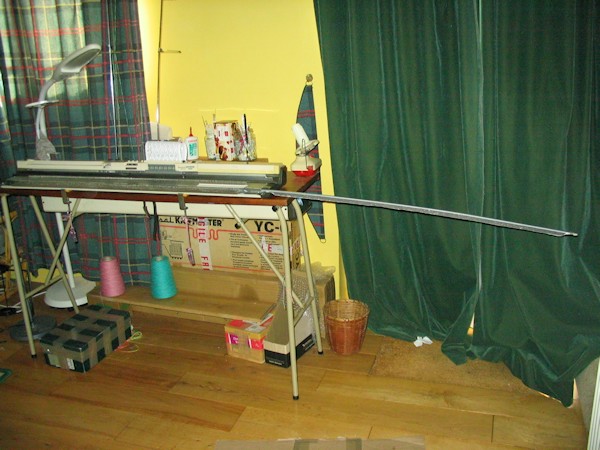
You also need space at the sides to get your sponge-bar in and out (if your machine has one).
.
You also need space for all your yarn, for tools, for accessories, for pattern, for your laptop/computer (if you are using knitting software). This storage space does not need to be near the machine if you are short of space.
.
You can store your machine under your bed or in the corner of a room when your machine is not being used.
.
Your Knitting Table
Your knitting machine is large and, if it has a metal bed, heavy. You need a long, sturdy table or frame to mount your machine. Most knitting machines are clamped to the table. If you are working on a dining room table, then you will want to make sure that the table is protected with cardboard before you try clamping your machine! This is not a good idea for the long-term but will do if there is no alternative or until you find your proper knitting table.
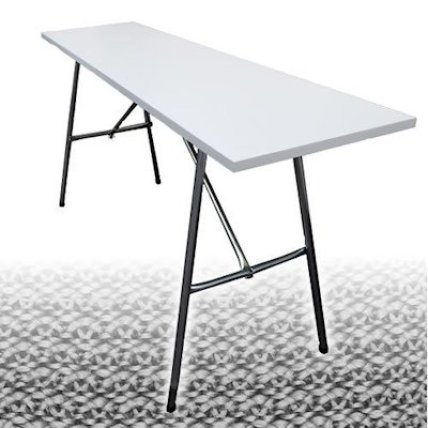
Traditional knitting machine that fold up can be found online. New ones can be purchased at Andee Knits or your local knitting machine supplier. They will probably deliver them by post. You can also find new and second-hand tables on Ebay or Gumtree for about £20. These knitting tables give enough room at the back to store some tools and weights and are my preferred option. You will usually need transport to pick these up, so keep looking until you find one within reasonable distance. Ask in charity shops or put up a notice in your local shop. Someone might have an old table you can buy.
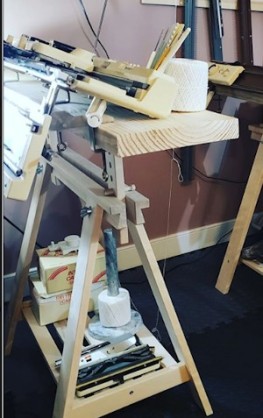
Recently a member of a Facebook Machine Knitting Group showed pictures of her knitting table using IKEA trestles (link here to UK site, costs about £25). A suitably sized plank of wood was firmly attached to the trestles to hold the machine. This seems like a good alternative if you have DIY skills (or know someone who has).
.
Lighting
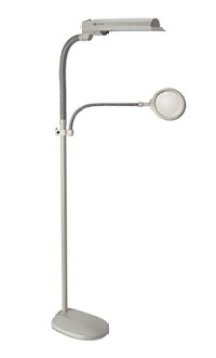
Get a good craft lamp so that you can see your stitches. This is especially important when you make mistakes and when you are casting off (binding off). Some people clamp a desk lamp to the knitting table. I do not like this idea. I need the room and it gets in the way when you are knitting (especially with colour changing). I prefer a floor lamp. I already had a suitable craft lamp with a magnifying glass that was perfect for my knitting. A father and son floor lamp would be good. You can move the lamp about and you can quickly move it out of the way when you need to. Even a cheap one like Argos one could suffice for those on a budget.
.
Pattern Holder/Computer Instruction
You need somewhere to put your instructions. If you have an electronic machine with software then you need a small table/desk/chair to put your computing device(s) near to the machine, but out of the way of the moving carriage.
.
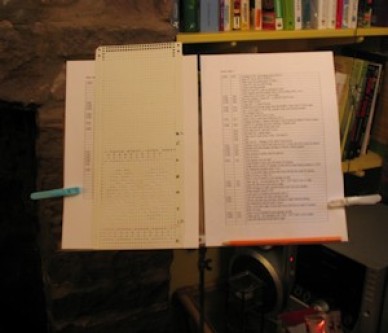
If you are following paper instructions (book, printout etc), then you need somewhere to place the paper where it will not be damaged or blow away. There used to be devices that you could attach to the mast or to the table, but are easily available today. I used a chair until I thought of my old music stand. It is ideal and a couple of plastic clothes pegs help to hold down the pages.
.
Tools
A range of tools will come with the machine. They will be found either in a plastic box or in a space in the machine itself. Or in case of plastic machine, they may just be in the box that the machine came in.
.
I often store these things in a cardboard tool box. I have one for each of my machines and they are labelled so that I do not mix them up.
.

The tools that you use most regularly ( transfer tools, weights, needle pusher, clothes pegs etc) can be placed on the table at the back of the machine so that they are always easily at hand. Jars, old cups etc. are useful to hold these items.
.
Some knitters also attached the lids of metal machines to the table in order to store longer items like ribber combs, cast-off combs and fine knit bars etc.

Ravel cord is useful for casting on and doing hems. It can also be used for holding stitches when partially knitting. If you do not have any ravel cord (cast-on nylon thread) with the machine, then you will need to purchase some. I got several colours (important as you need a contrast colour) for a few pounds. You buy some online e.g. from Andee Knits. This is useful for casting on and for making double hems.
.
In addition, you also need a pen/pencil, rubber, scissors close at hand. Your machine will come with weights and I find it useful to store these at the back of the machine on the table.

I also find a set of digital kitchen scales very useful for weighing yarn and finished garments. It is useful to know how much yarn is left on a cone and how much you might need to do another jumper.
.
Yarn
You will want to acquire lots of practice yarn and nice yarn for actual garments etc. You need space to store this.

I have yarn on shelves, in cardboard boxes, in underbed storage boxes and piled up in the corridor (yes I am a bit of an addict!).
.
I also have used a lidl shoe organiser to hold my yarn. This is quite useful because it does not take up too much floor space and you can rotate the shelves to view your yarn. (see this post for more information)
.
I do place each cone of yarn in a plastic bag (I recycle the ones used for getting vegetables from the supermarket) and stick on a label describing the yarn.
.
When knitting with my cones of yarn, I tend to put these on the floor behind the machine, although some people will put them on the table behind the machine.
.
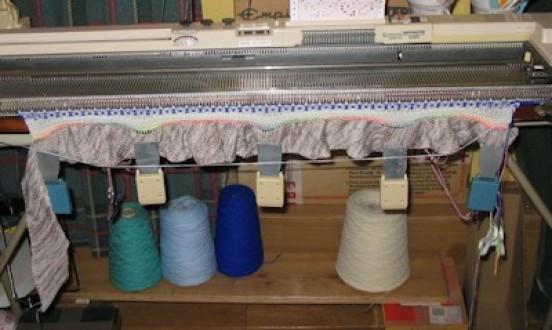
I always kept kicking my yarn, so I have added a shelf a few inches off the floor so that my feet now go under the shelf.
.
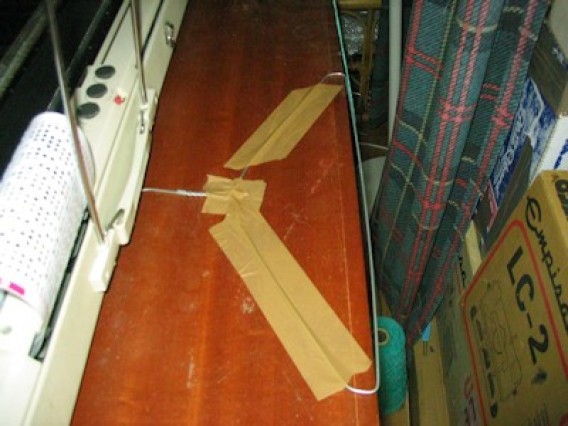
I have also taped down an old metal clothes hangar to the back of the table so that it just hangs over the edge. This stops the yarn from rubbing against the back of the table. It might not look pretty, but the yarn is happily running smoothly over the round metal. This is a great, inexpensive idea that I would recommend.
.
Books, Patterns etc
You will need somewhere to store the books and patterns that you will accumulate as your learn. I have a lot of electronic pdf patterns and magazines that I download online. I then print out the pattern that I want to try and store them in plastic wallets inside a folder.
.

I also view the magazines and patterns on my computer and take a screen shot ( I use the microsoft snipping tool) and save these with a name that includes a reference to the pattern or magazine. I put these in a folder on my computer and then spend many hours perusing these and dreaming of the garments that I will be able to knit.
.
I also snip and save images of garments that inspire me. I hope to be able to do something similar in the future.
.
So these are a number of ideas that I have for setting up your knitting area. Have fund creating a wonderful space for yourself.
.
Happy Knitting!
.
Carol
.
.




